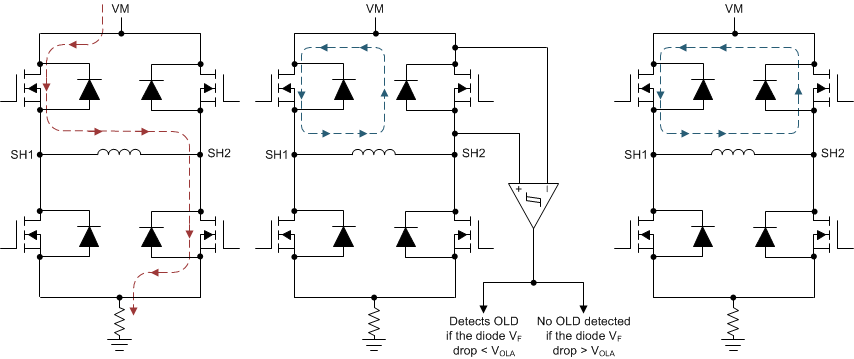SLVSET1 August 2018 DRV8873
PRODUCTION DATA.
- 1 Features
- 2 Applications
- 3 Description
- 4 Revision History
- 5 Pin Configuration and Functions
- 6 Specifications
-
7 Detailed Description
- 7.1 Overview
- 7.2 Functional Block Diagram
- 7.3 Feature Description
- 7.4 Device Functional Modes
- 7.5 Programming
- 7.6 Register Maps
- 8 Application and Implementation
- 9 Power Supply Recommendations
- 10Layout
- 11Device and Documentation Support
- 12Mechanical, Packaging, and Orderable Information
Package Options
Mechanical Data (Package|Pins)
- PWP|24
Thermal pad, mechanical data (Package|Pins)
- PWP|24
Orderable Information
7.3.2.4.2 Open-Load Detection in Active Mode (OLA)
Open load in active mode is detected when the OUT1 and OUT2 voltages do not exhibit overshoot greater than the VOLA over VM between the time the low-side FET is switched off and the high-side FET is switched on during an output PWM cycle, as shown in Figure 20. An open load is not detected if the energy stored in the inductor is high enough to cause an overshoot greater than the VOLA over VM caused by the flyback current flowing through the body diode of the high-side FET. The OLA diagnostic is disabled by default and can be enabled by writing a 1b to the EN_OLA bit in IC4 control register.
 Figure 20. Open-Load Active Mode Circuit
Figure 20. Open-Load Active Mode Circuit In PH/EN and PWM mode, the motor current decays by high-side recirculation. In independent PWM mode, the motor can enter the brake state either by high-side or low-side recirculation. If the motor enters the brake state using low-side recirculation, the diode VF voltage of high-side FET is less than the VOLA voltage which flags an open load fault even though the load is connected across the OUT1 and OUT2 pins. In this case, the OLA mode should not be used. If high-side current recirculation is done with independent PWM mode, the OLA mode functions properly.
NOTE
The OLA mode is functional only when high-side recirculation of the motor current occurs. Depending on the operation conditions and external circuitry, such as the output capacitors, an open load condition could be indicated even though the load is present. This case might occur, for example, during a direction change or for small load currents with respectively small PWM duty cycles. Therefore, TI recommends evaluating the open load diagnosis only in known, suitable operating conditions and to ignore it otherwise.
To avoid inadvertently triggering the open load diagnosis, a failure counter is implemented. Three consecutive occurrences of the internal open-load signal must occur, essentially three consecutive PWM pulses without freewheeling detected, before an open load condition is reported by the nFAULT pin and in the SPI register.
In the hardware version of the device, OLA mode is active when the nOL pin if left as a no-connect pin or tied to ground. If low-side current recirculation is done with independent PWM control, an open load condition is detected even though the load is connected. To avoid this false trip, the OLD must be disabled by taking the nOL pin high; however, both OLA and OLP diagnostics will be disabled.